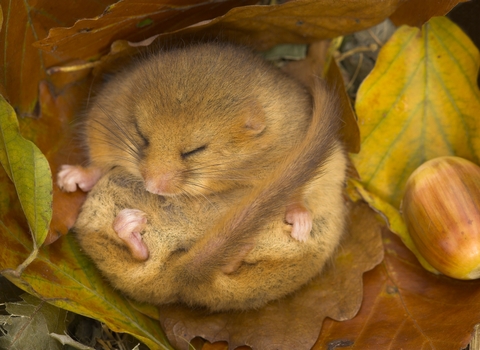
Young hazel dormouse by Terry Whittaker/2020VISION

©Danny Green
Hazel dormouse
Scientific name
Muscardinus avellanariusWhen to see
April to OctoberSpecies information
Category
Statistics
Length: 6-9cmTail: 5.7-6.8cm
Weight: 15-40g
Average lifespan: 5 years
About
Dormice are barely ever seen due to the fact they spend most of the day asleep! At night they come alive, climbing high into the trees on the hunt for a tasty snack. Their favourite foods are hazelnuts, berries and insects. Dormice build nests out of grass and leaves ready for the female to give birth to up to seven young. In autumn, dormice start looking for the perfect spot to hibernate for winter. They often choose to sleep in logs or leaves at the base of trees or just beneath the ground where they can avoid the winter cold.How to identify
The hazel dormouse has gingery-brown fur, large black eyes and a long, fluffy tail; it is much smaller than a squirrel.Distribution
Mainly found in southern England and Wales.In our area
Dormice are widespread across Montgomeryshire, but never numerous or common. Expect them to be in any well-connected, good sized, healthy woodland.
We have dormice on four nature reserves - Coed Pendugwm, Cors Dyfi, Dolforwyn Woods and Dyfnant Meadows. We carry out National Dormouse Monitoring Programme (NDMP) surveys on all these sites, contributing to our understanding of the species on a national level.
Did you know?
Hazel dormice, like many of our other small animals, hibernate through the winter months in order to survive. If food is scarce outside of hibernation season, they can save energy by dropping their body temperature and going into a state of 'torpor'. In fact, dormice can spend nearly three-quarters of the year 'asleep' in some form!Dormice are widespread across Montgomeryshire, but never numerous or common. Expect them to be in any well-connected, good sized, healthy woodland.
We have dormice on four nature reserves - Coed Pendugwm, Cors Dyfi, Dolforwyn Woods and Dyfnant Meadows. We carry out National Dormouse Monitoring Programme (NDMP) surveys on all these sites, contributing to our understanding of the species on a national level.

